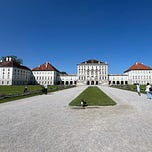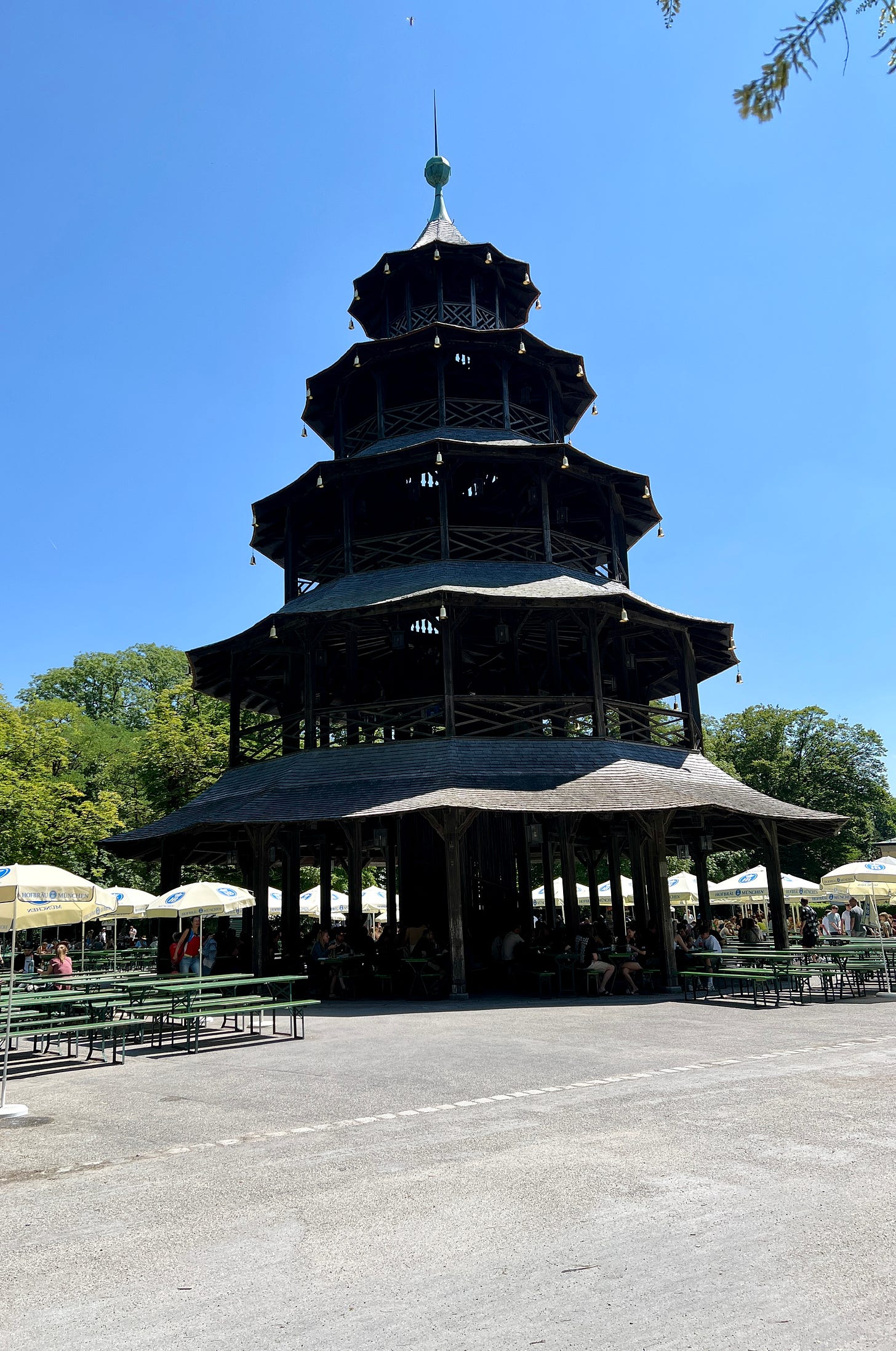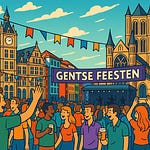Both: Hey everyone!
Jen: It's Jen and Greg with an update on our travels.
Greg: This update, we're going to talk about the five days that we spent in Munich. So it may take a couple of updates to get through all of it.
Jen: Yeah. We did a lot of sightseeing, but we also had some downtime, which we used to plan the next leg of our journey.
Greg: Yeah, so specifically in this update, we're going to talk about Nymphenburg Palace. We're going to talk about the English Garden and generally how we felt about Munich.
Jen: Yeah, I think my first impression of Munich was really that it was so much different than what we had come from before. We had come from a quaint little German town of Heidelberg to a more metro area for sure.
Greg: Yeah, but it was very clean. It was very orderly. There were some really cool buildings and stuff. We never really found out what they were. But when we were walking from the train station to our hotel, we went through the two main squares, Karlsplatz and Marienplatz, that we saw concert performance, a lot of people around a fountain, a lot of people shopping. It was pretty cool.
Jen: Yeah, the weather was great the whole time we were there, really.
Greg: Yeah.
Jen: And the city felt really familiar and it didn't feel very foreign to us.
Greg: Right. Although I did have one kind of small problem. When you first look at going to Europe, a lot of people tell you there's no tipping culture. Don't tip wherever you go. We found that that wasn't really the case. But Germany, specifically Munich, when they interacted with us - and realized we were American - all of a sudden there was an expectation of tipping. In some cases, they outright asked us what we wanted to tip.
Jen: Yeah, it was kind of awkward.
Greg: Yeah. But other than that, it was a really cool place. I, I appreciated it.
Jen: We know you guys love these fun facts, so let me tell you one about how Munich got its name. The city was founded in 1158 by a group of Benedictine monks, and it was called Munichen, which means “by the monks”. And now it's just shortened to Munich.
Greg: Yeah, it's also the capital of Bavaria, which means brewing culture and beer culture is very big. Oktoberfest is very big there.
Jen: We weren't there during Oktoberfest, so we didn't get to experience that. But we learned that Munich is a lot more than just the beer culture. It's also a major tech and finance hub, as well as the headquarters to BMW.
Greg: Yeah, and BMW has a little museum with their headquarters, which we didn't really get a chance to go to. But there are several big companies that are headquartered in Munich.
Jen: Yep.
Greg: So we learned some of these things we mentioned because of these neat little almost mini baseball cards that were at our hotel. We noticed right away when we went in.
Jen: Yeah, I think since we're both former baseball/sports cards collectors that we were really drawn to this display.
Greg: Yeah.
Jen: They were really cool because they had pictures of the different attractions. And then on the back, they had a description about them and a map kind of, of where they were in the city.
Greg: Well, yeah. And they also color coded them. So it was like if this is a architectural thing or a food thing, it was different colors.
Jen: Yeah. So we took one of each card and went back to the room and kind of planned our next five days from these cards.
Greg: Yeah. No, it was super useful. And one of the first ones that we picked out was Nymphenburg Palace.
Jen: Nymphenburg Palace was the former home of German royalty, and it was commissioned in 1664 by Elector Ferdinand Maria and his wife, Henriette Adelaide of Savoy. They had struggled for many years to get pregnant and have an heir to the throne. So when they finally succeeded and the child was born, they felt that the way to celebrate that… was a house.
Greg: I mean, a massive house. (laughs)
Jen: (laughs)
Greg: Yeah, it's interesting. The, the palace initially was just the one center building, which by today's standards, we would just call a mansion. But over a long period of time, they just kept adding to it. And it changed the style of the whole thing because, you know, I thought it was just going to be this Baroque palace like anywhere else. But you go through it and you, you learn, because I didn't know the difference, that it pulled in trends of French Rococo, Neoclassical, and it was really a beautiful building. But, you know, that's not the first impression you get when you walk up to it…
Jen: (laughs) Yeah, the first thing you notice is a big water feature with, like, 12 or 15 geese.
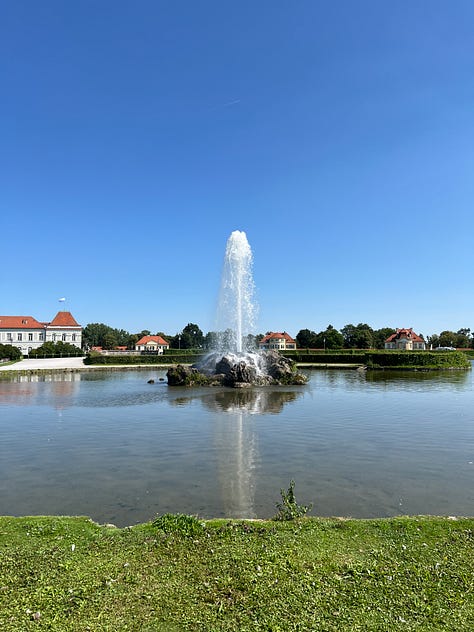
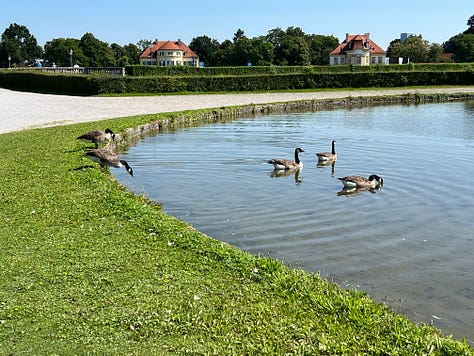
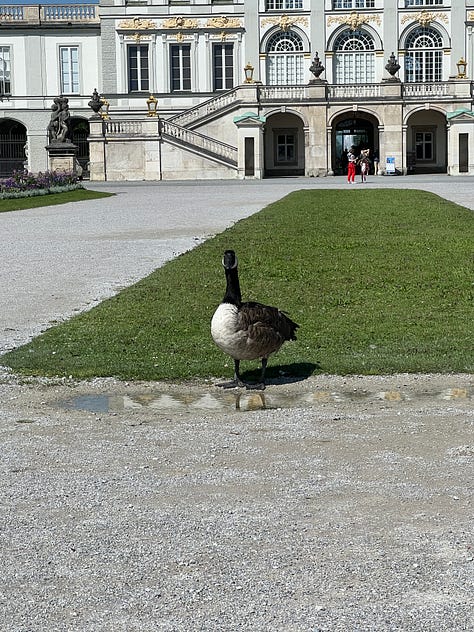
Greg: Right. But the first impression you get is the extreme amounts of geese poop everywhere.
Jen: (laughs) Okay, let's not focus on the geese poop…
Greg: No, really, it's a beautiful building. And once you get past the whole geese and geese poop, it is a marvelous sight, especially all of the windows.
Jen: Yeah, it makes the inside really light and a lot different than what we had experienced before in some of the other palaces we went that had dark paneling and dark painted walls. When you walk into this one, almost all the walls are, like, white or a very light color. And the windows just provide so much natural light. It makes it really great to walk through.
Greg: Well, yeah, because when you compare it to, say, Versailles, all of the windows have shading and blocking in front of them because they have to protect all of the furniture and the painting and the walls from the sun. As where here, it's just beautiful inside because all the windows are allowed to display that light.
Jen: Yeah. And one of the first rooms that you go into is this ballroom that the whole ceiling - it's kind of a curved ceiling - and it's painted with this mural of, like, cherubs and clouds and just really light colors. And it's so cool to look at. You have to kind of dodge people who are staring up at the ceiling. And then you notice that the flooring is pretty amazing as well.

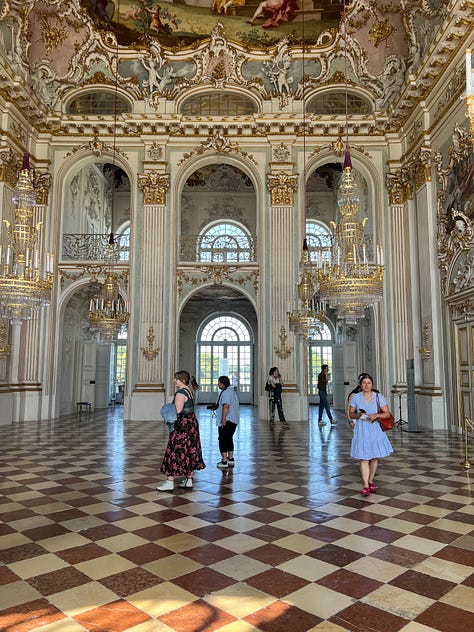
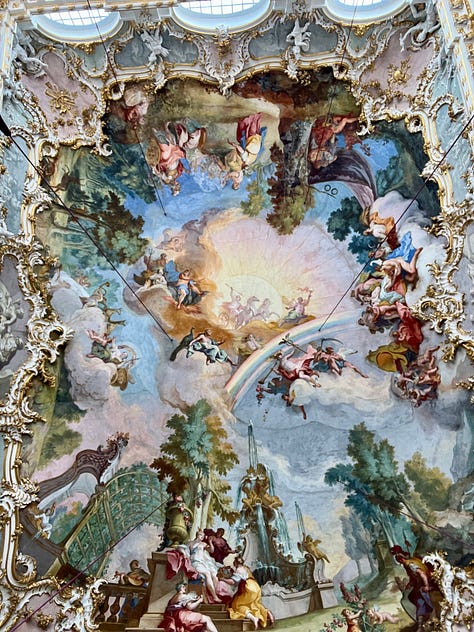
Greg: Yeah, I mean, the whole thing outside and in, you do feel the inspiration from Versailles, but it's not like they just tried to copy Versailles. You could just see the subtle things that make you feel like you're back there.
But I think my favorite part of Nymphenburg Palace was all of the artwork throughout that showed the building itself, as you continue going through each artwork, would show you the evolution of the palace itself, which I just thought was really cool.
Jen: Yeah, it was kind of like an early version of before and after remodel photos. (laughs)
Greg: (laughs) Yeah.
Jen: One of the other cool rooms that I kind of thought was fun was, like, a gallery of all these individual portraits of women. And they were deemed to be - by King Ludwig- the most beautiful of all the women. And he commissioned about one or two a year, so it took about 30 years to build this gallery. But it was just kind of neat to be able to see the change in what was considered beautiful of the time. And then as well as the art style, too.
Greg: Yeah, you can definitely see the changing of fashion and the trends, uh, hairstyle and dress. It, it was neat.
Jen: Other than the inside of the palace, we also really enjoyed the gardens in the back. I think we spent about an hour outside.
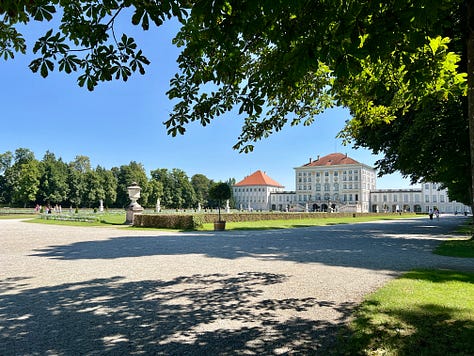

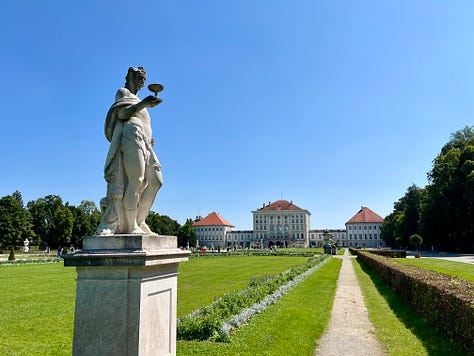
Greg: Yeah, and speaking of Versailles yet again, you definitely get a very strong feeling of the gardens from Versailles when you are in the gardens at Nymphenburg Palace.
Jen: Yeah, and that's actually because these gardens were redesigned in about the 18th century by a student of the man who designed the Versailles Gardens.
Greg: Yeah, it was a really nice day, too, which I think contributed to us spending so much time in the gardens.
Jen: Yeah, and there were no geese in the back garden.
Greg: Yeah. Lots of people, though, walking with dogs and kind of just exploring it. I think it's a popular place for people to just go and walk around.
Jen: Yeah.
Greg: So, yeah, we really enjoyed our time at Schloss Nymphenburg.
Jen: (laughs)
Greg: From there, we went to Munich's version of Central Park.
Jen: The English Garden is a really sprawling park, but it's a lot more informal and open than Central Park.
Greg: Yeah, so the English Garden is bigger than Central Park. It's one of the largest urban parks in the world. But we specifically learned how big it was because we picked the wrong entrance and had to walk through most of it to get to where we wanted to see.
Jen: Yeah, what we planned to see was the Chinese Tower and the Beer Garden area. But we were able to explore some of the different paths and see a lake with paddle boats and everything.
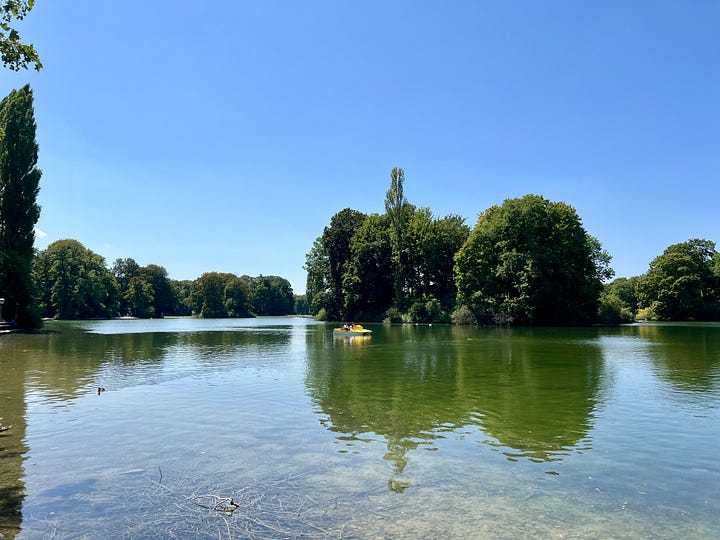

Greg: Yeah, it was an enjoyable walk. I, I feel like maybe we should call it a stroll.
Jen: (laughs)
Greg: But when we got to the Chinese Tower, it's just the structure they built to mimic Chinese architecture. But there's, like, a brewery and a little restaurant. And it's really just a gathering point that people hang out. We were kind of too hot and, and didn't really feel like eating anything. We're not really big on beer. So we just kind of soaked it all in. And it was really lively and we liked the time we spent there.
Jen: Yeah, we were able to find a spot kind of in the shade. So I think we hung out there a little longer than probably we should have. (laughs)
Greg: Yeah.
Jen: But people watching is probably one of my favorite things to do. And there was a lot of that there.
Greg: Yeah. Eventually, we got back on our way and walked through a different part to get to a different exit so we could see more. And we passed these open areas where people would be sunbathing. And there was even the stream that cuts through one section where people are allowed to wade into it and kind of hang out in the cool water.
Jen: Yeah. And we didn't find this out ‘til later, but that spot of the park is actually a “clothing optional” spot of the park…
Greg: Yes, no nudity. Good thing.
Jen: Yeah, we didn't see any of that. Um, not disappointed. (laughs)
Greg: Yeah. Maybe in Spain we would have felt differently.
Jen: (laughs)
Greg: Oh, beautiful people in Spain…
Jen: (laughs)
Greg: Yeah, so I think this is a good spot to break it up. This update, Schloss Nymphenburg, the English Garden, both really enjoyable for us. If you find yourself in Munich, we highly suggest you do those things.
Jen: Yeah, there's definitely a lot of things to see in Munich, as well as a lot of opportunities to just relax and hang out. There were several beer gardens, uh, that we unfortunately didn't go to. But if that's your thing, there's plenty of opportunities for that.
Greg: Yeah. So the next update, we're going to talk about Neuschwanstein Castle, which was a full experience.
Jen: One of the most memorable things about that trip for me was the bridge that you have to cross to go get your epic shot of the castle that happens to be over about a thousand foot drop over a gorge.
Greg: Yeah. (laughs)
And a lot of people were very nervous on that bridge. But overall, Neuschwanstein Castle should be fun to talk about.
Jen: Yeah, it was really cool to see.
Greg: So thanks for checking in!
Jen: And we'll see you at the next stop!


